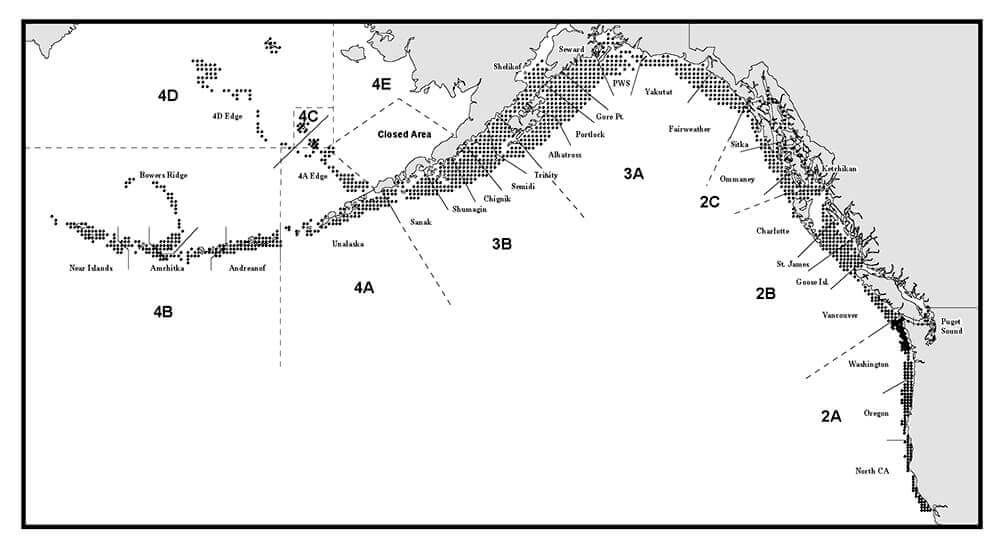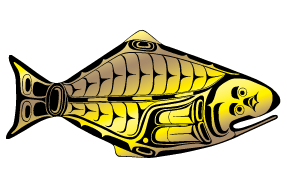IPHC Fishery-Independent Setline Survey (FISS)
The purpose of the FISS is to collect standardized data for use in the Pacific halibut stock assessment. This information is used to study aspects of the Pacific halibut resource such as growth, distribution, biomass, age composition, sexual maturity, and relative abundance of other species. All legal-sized Pacific halibut (over 32-inch [81.3 cm] fork length) and some bycatch will be sampled for biological data, retained, and sold by the IPHC to offset survey expenses. The IPHC contracts with experienced longline vessel owners who fish commercially for Pacific halibut to conduct the FISS.

The FISS covers the majority of Pacific halibut fishing grounds within the IPHC Convention Area with a 10 by 10 nautical mile grid of stations ranging from California to the northern Bering Sea including the Aleutian Islands. Vessels fish four to eight skates of gear at each station in most regions, following standard FISS protocol. A maximum of four stations may be fished per day. Most regions require 12-22 fishing days plus additional days for running, loading and offloading gear and fish, foul weather days, etc. Depending on the region, total charter duration can be expected to be 20-36 days in duration. Vessels are encouraged to bid for multiple areas, and may be awarded up to a maximum of four regions.
To learn more about putting your vessel and crew to work on IPHC’s FISS, visit Survey Vessel Recruiting.
Protocol overview
Depending on data needs, between four and eight skates of baited gear are set at each FISS station. FISS specifications for gear, setting schedule, and soak time have been consistent since 1998. FISS gear consists of fixed-hook or snap gear, 1,800-foot (549 m) skates with 100 16/0 (#3) circle hooks baited with 0.25 lb to 0.33 lb (0.11 kg to 0.15 kg) of chum salmon (Oncorhynchus keta) and spaced 18 feet (5.5 m) apart on gangions ranging from 24 to 48 inches (61 cm to 122 cm). A vessel may set one to four stations daily beginning after 5 AM, and must soak the gear at least five hours before hauling, avoiding soaking the gear at night when possible. All legal-size and a subsample of sublegal-size Pacific halibut are sacrificed as part of sampling, except specimens that are intended to be tagged and released. Most trips are 5 – 7 days in length, except in remote regions of the Bering Sea and western Aleutian Islands, where trips can be twice as long. The vessel crew is responsible for processing (i.e. dressing, wet-scraping, and icing) Pacific halibut and other fish (rockfish and Pacific cod) retained for sale. Note that in addition to Pacific halibut, IPHC retains only rockfish (Sebastes spp.) and Pacific cod for sale because those species die from barotrauma resulting from capture.
A FISS set is considered ineffective for use in the stock assessment when predetermined limits for lost gear, snarls, depredation, or displacement from station coordinates are exceeded. For details on the IPHC FISS sampling methods, please refer to the following manual:
To learn more about working as a setline survey specialist on IPHC’s FISS, visit Working as an IPHC Setline Survey Specialist (Field).
Vessel requirements
Vessels need not be licensed for Pacific halibut fishing in Canada or the U.S.A. to be eligible. The IPHC is not restricted as to nationality of the vessels it charters for operation in any region as long as customs and immigration regulations are followed. However, the IPHC will consider only those vessels with captains and crews that have Pacific halibut fishing experience within the last five years. Most areas require vessels that have adequate deck space and suitable accommodations for two to three IPHC employees. Vessels must supply conventional fixed-hook or snap setline gear conforming to IPHC standards as well as all associated equipment normally required for commercial Pacific halibut fishing. Interested vessel owners should visit Survey Vessel Recruiting for more details.

